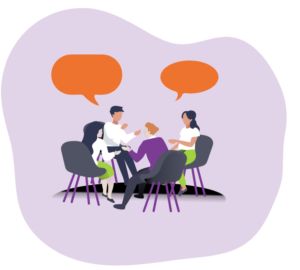
Raising the Bar on Employment Engagement with Impactful Digital Solutions
Those who know me know that I am obsessed with experimenting with new digital collaboration platforms and technologies. These days I’m especially intrigued with those that can help build trust, reduce loneliness and strengthen social connectivity; and, in so doing improve employee engagement, cross-functional collaboration, and organizational culture health. These topics are on everyone’s minds as companies envision much more remote or hybrid remote work becoming much more permanent due to the pandemic.
Last December I had the honor of participating in an immersive gathering of organizational culture trailblazers organized by Share Ventures, (an LA based venture studio committed to reimagining start-up building) and Instill (a start-up building solutions for a new software category, ‘Culture Management as a Service’). The objective of the conference was to bring together people from sports, the military, business, academia, and the venture capital worlds that are committed to building positive organizational cultures. The panel of speakers and their innovative approach to virtual conference participant engagement was inspirational. (Click here to see a conference recap) The conference introduced me to two innovative solutions that I believe could be very useful for building trust and improving employee experience.
 KeepWOL (Wondering Out Loud) was initially brought to market as a physical question and answer game, similar to Trivial Pursuit. Their ‘as-a-service’ software version, now available, is used to create fun, meaningful employee engagement experiences in a unique and different way. KeepWOL’s novel employee engagement process “creates an environment where participants are rewarded for being genuine, empathetic and sharing communally, which makes it simple to discover authentic insights into who teammates are and what they’ve experienced.” according to KeepWOL’s founder and CEO Lauren Fitzpatrick Shanks.
KeepWOL (Wondering Out Loud) was initially brought to market as a physical question and answer game, similar to Trivial Pursuit. Their ‘as-a-service’ software version, now available, is used to create fun, meaningful employee engagement experiences in a unique and different way. KeepWOL’s novel employee engagement process “creates an environment where participants are rewarded for being genuine, empathetic and sharing communally, which makes it simple to discover authentic insights into who teammates are and what they’ve experienced.” according to KeepWOL’s founder and CEO Lauren Fitzpatrick Shanks.
With facilitators trained in bringing out the curiosity and courage that participants need to truly form connections, KeepWOL games can suit any ‘team building or team bonding’ effort a leader has planned. Accessing a database of over 1,000 questions, there are pre-designed formats for games focused on overall team connection (KeepWOL for ALL), diversity and inclusion (KeepWOL – PATHS TRAVELED) and career planning (KeepWOL – YOUR CAREER) –with more to come. The games can be deployed as 90-120 minute sessions for onboarding, networking events, diversity and inclusion initiatives, retreats, staff re-engagement, happy hours, town hall panels, and even C-suite round tables.
 The KeepWOL team has measured and verified results that reveal these engagement activities build happier, stronger, and higher performing teams. “By bringing together all generations and backgrounds in a safe space with means to help them more effectively listen, dig below the surface and communicate, and empathize with one another in a facilitated way; respect, loyalty, and a sense of camaraderie are greatly enhanced,” Lauren said. With more curiosity, courage, and connections, KeepWOL has found that teams get re-energized in ways that help minimize employee turnover, maximize macro and micro culture sensitivity and more effectively socially engage and connect remote teams.
The KeepWOL team has measured and verified results that reveal these engagement activities build happier, stronger, and higher performing teams. “By bringing together all generations and backgrounds in a safe space with means to help them more effectively listen, dig below the surface and communicate, and empathize with one another in a facilitated way; respect, loyalty, and a sense of camaraderie are greatly enhanced,” Lauren said. With more curiosity, courage, and connections, KeepWOL has found that teams get re-energized in ways that help minimize employee turnover, maximize macro and micro culture sensitivity and more effectively socially engage and connect remote teams.
 Instill’s research shows that firms with extremely healthy cultures are 150 percent more likely to report revenue gains and 250 percent more likely to report stock price increases, attract the best new talent, and retain existing employees. Armed with these insights, their mission is to digitally connect team performance and organizational excellence. They do so by building a ‘culture operating system’ that helps companies design, build, and scale high-performing cultures, especially in remote or hybrid remote work environments. This new software category, called ‘Culture Management as a Service’ creates a real-time, data-driven dashboard that leaders can use to understand the cultural implications of strategy and execution changes a company implements.
Instill’s research shows that firms with extremely healthy cultures are 150 percent more likely to report revenue gains and 250 percent more likely to report stock price increases, attract the best new talent, and retain existing employees. Armed with these insights, their mission is to digitally connect team performance and organizational excellence. They do so by building a ‘culture operating system’ that helps companies design, build, and scale high-performing cultures, especially in remote or hybrid remote work environments. This new software category, called ‘Culture Management as a Service’ creates a real-time, data-driven dashboard that leaders can use to understand the cultural implications of strategy and execution changes a company implements.
The Instill solution starts by assessing psychometric and demographic traits that define an organization’s structure and environmental characteristics. Then, it conducts a sentiment analysis of the intra-company communication platforms that the company uses. Finally, Instill conducts a ‘working norms evaluation’ that assesses such aspects as burnout risk, retention metrics, time spent in FLOW, psychological safety, job satisfaction, and existing innovation capability.
 Highly secure, AI (artificial intelligence) and advanced data mining techniques interpret the data and deliver a real-time performance dashboard. This dashboard includes an index of overall team health, weighting 10 factors; FLOW, employee engagement, productivity, innovation, psychological safety, burnout risk, respect and inclusion, development, and job satisfaction. This index is updated in real-time, so teams can see how their ‘culture health’ ebbs and flows, and identify (and more deeply understand) the underlying factors that determine their score. With this index, leaders can immediately see when their teams operate ‘at peak’. Leaders get a big picture view of how teams can work better by using data, not just gut feel, to tap into each team member’s strengths and communication styles. With a comprehensive picture of how team performance can be optimized, these highly tailored, anonymized insights and action plans can be used to nudge leaders to use the learnings to make their culture a competitive advantage.
Highly secure, AI (artificial intelligence) and advanced data mining techniques interpret the data and deliver a real-time performance dashboard. This dashboard includes an index of overall team health, weighting 10 factors; FLOW, employee engagement, productivity, innovation, psychological safety, burnout risk, respect and inclusion, development, and job satisfaction. This index is updated in real-time, so teams can see how their ‘culture health’ ebbs and flows, and identify (and more deeply understand) the underlying factors that determine their score. With this index, leaders can immediately see when their teams operate ‘at peak’. Leaders get a big picture view of how teams can work better by using data, not just gut feel, to tap into each team member’s strengths and communication styles. With a comprehensive picture of how team performance can be optimized, these highly tailored, anonymized insights and action plans can be used to nudge leaders to use the learnings to make their culture a competitive advantage.
Instill’s methodology includes a process that helps teams to craft their mission, vision, and core values in a scalable, dynamic way. The resulting ‘culture deck’ provides a framework for employees to get greater buy-in of their core values, ensuring they’re embedded into multiple business processes. As Instill General Manager and Share Ventures Principal William Litvack shared with me, “The Instill platform pairs real-time actions with real-time insights to ensure that organizational and team culture continues to thrive, even in remote or hybrid work environments.”
 A third solution, from GetImmersion, I found through a webinar sponsored by Harvard Medical School’s Institute of Coaching. With neuroscience at its core and based on work by long time neuroscience researcher Paul Zak, its overall goal of helping teams build relationships by getting and staying connected as are the other two solutions. But its approach is a bit different as it involves helping leaders and coaches become more acutely aware of how they’re connecting in-the-moment. They do this by using a wearable sensor, such as an Apple watch, to measure participant brainwaves during a group event or activity. The end result is a set of impact metrics that GetImmersion says measure four social connection attributes or factors that need to be considered when assessing social connectivity effectiveness namely:
A third solution, from GetImmersion, I found through a webinar sponsored by Harvard Medical School’s Institute of Coaching. With neuroscience at its core and based on work by long time neuroscience researcher Paul Zak, its overall goal of helping teams build relationships by getting and staying connected as are the other two solutions. But its approach is a bit different as it involves helping leaders and coaches become more acutely aware of how they’re connecting in-the-moment. They do this by using a wearable sensor, such as an Apple watch, to measure participant brainwaves during a group event or activity. The end result is a set of impact metrics that GetImmersion says measure four social connection attributes or factors that need to be considered when assessing social connectivity effectiveness namely:
- Immersion Factor–a direct measure of how people love an experience.
- Readiness Factor –a measure of participants’ psychological safety.
- WOW Factor–a measure of the most thrilling parts of an experience.
- BLAH Factor–a measure of an experience’s low points where people tune out.
Some examples of where this distributed neuroscience platform can be used are:
- Event management – Analysis of the high and low points to design emotional highlights into the event.
- Job satisfaction – identification of factors that can improve job satisfaction, and reduce absenteeism and employee turnover.
- Training programs – Recognition of learning capacity and how to optimize learning content for various training activities.
- Coaching Effectiveness – Analysis of the high and low points and effectiveness of coaching or mentoring sessions.
- Talent assessment – knowledge of who’s ready for a promotion and who needs additional coaching.
 In the webinar Paul Zak, a key principal at GetImmersion, suggested that their solution could also be used by leaders for predicting the impact their leadership style might have on knowledge retention with their teams, identifying who the team ‘Learner Champions’ are, understanding specific topics or activities that lead to participant frustration or measuring psychological safety and tracking what efforts create learning champions.
In the webinar Paul Zak, a key principal at GetImmersion, suggested that their solution could also be used by leaders for predicting the impact their leadership style might have on knowledge retention with their teams, identifying who the team ‘Learner Champions’ are, understanding specific topics or activities that lead to participant frustration or measuring psychological safety and tracking what efforts create learning champions.
All of these solutions are fascinating and futuristic. I’m ‘all in’ and look forward to working with experiential leaders to try them out. If that describes you or someone you know, give me a shout. (gclemson@globalinkage.net)


Be the first to comment